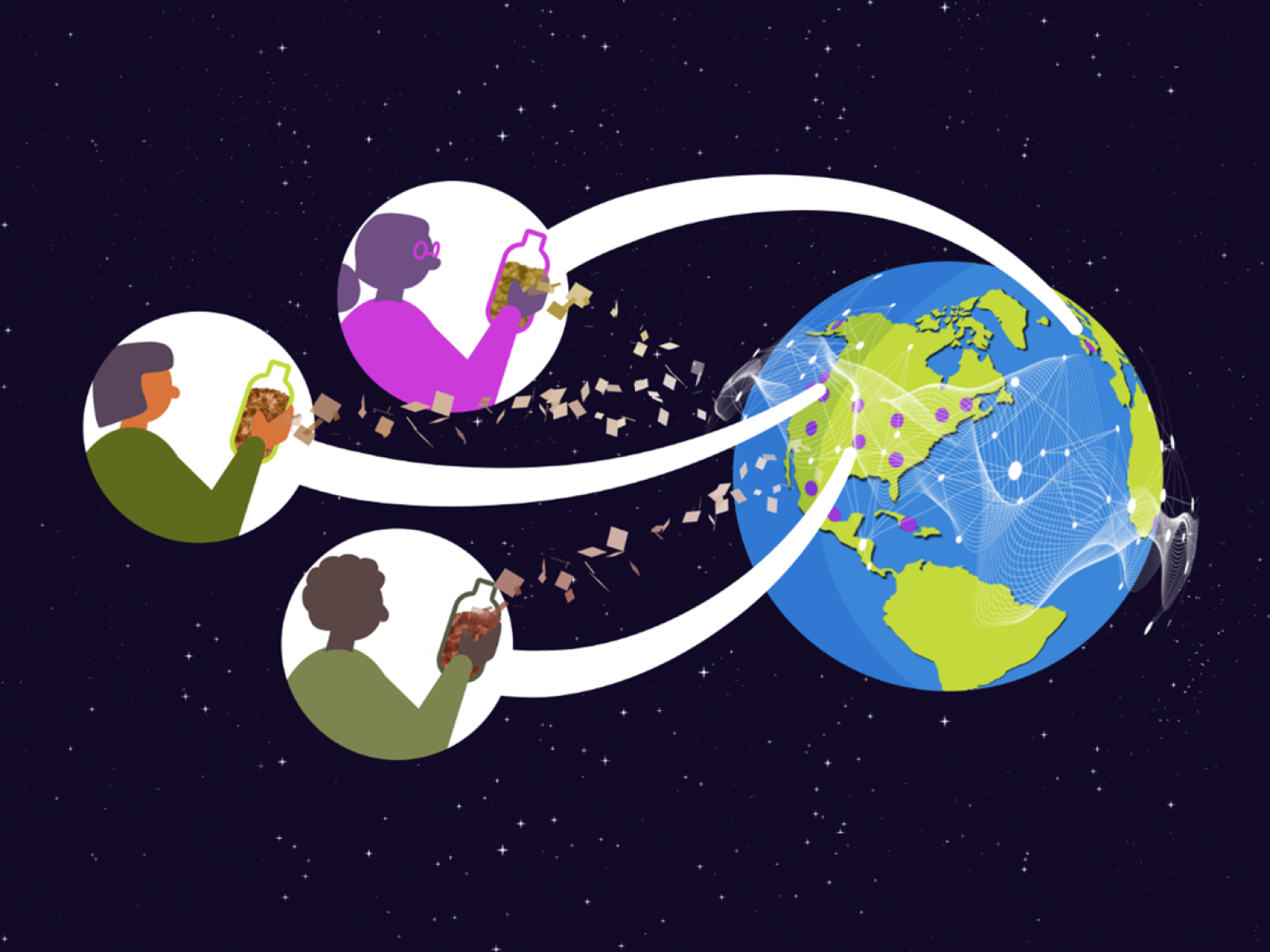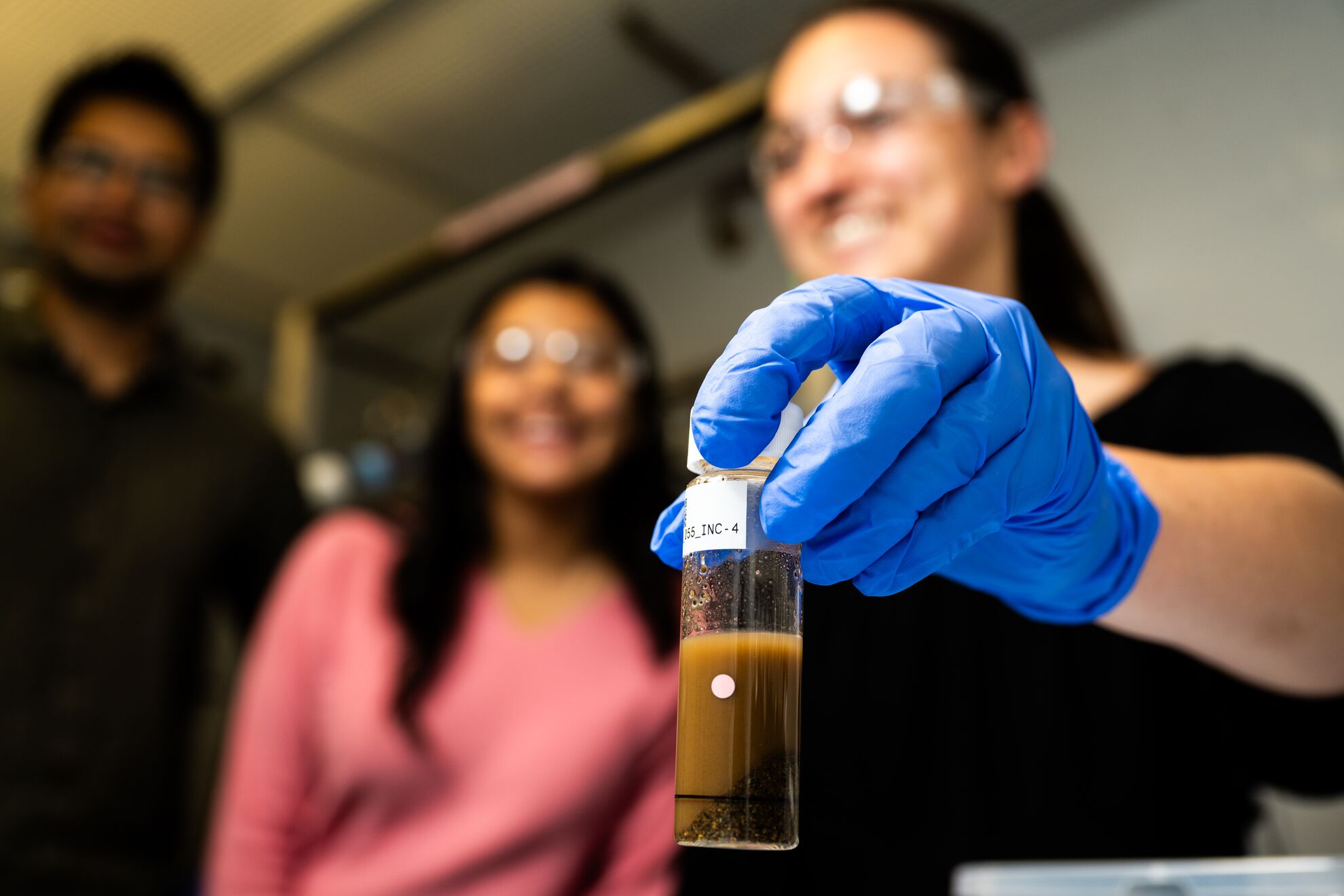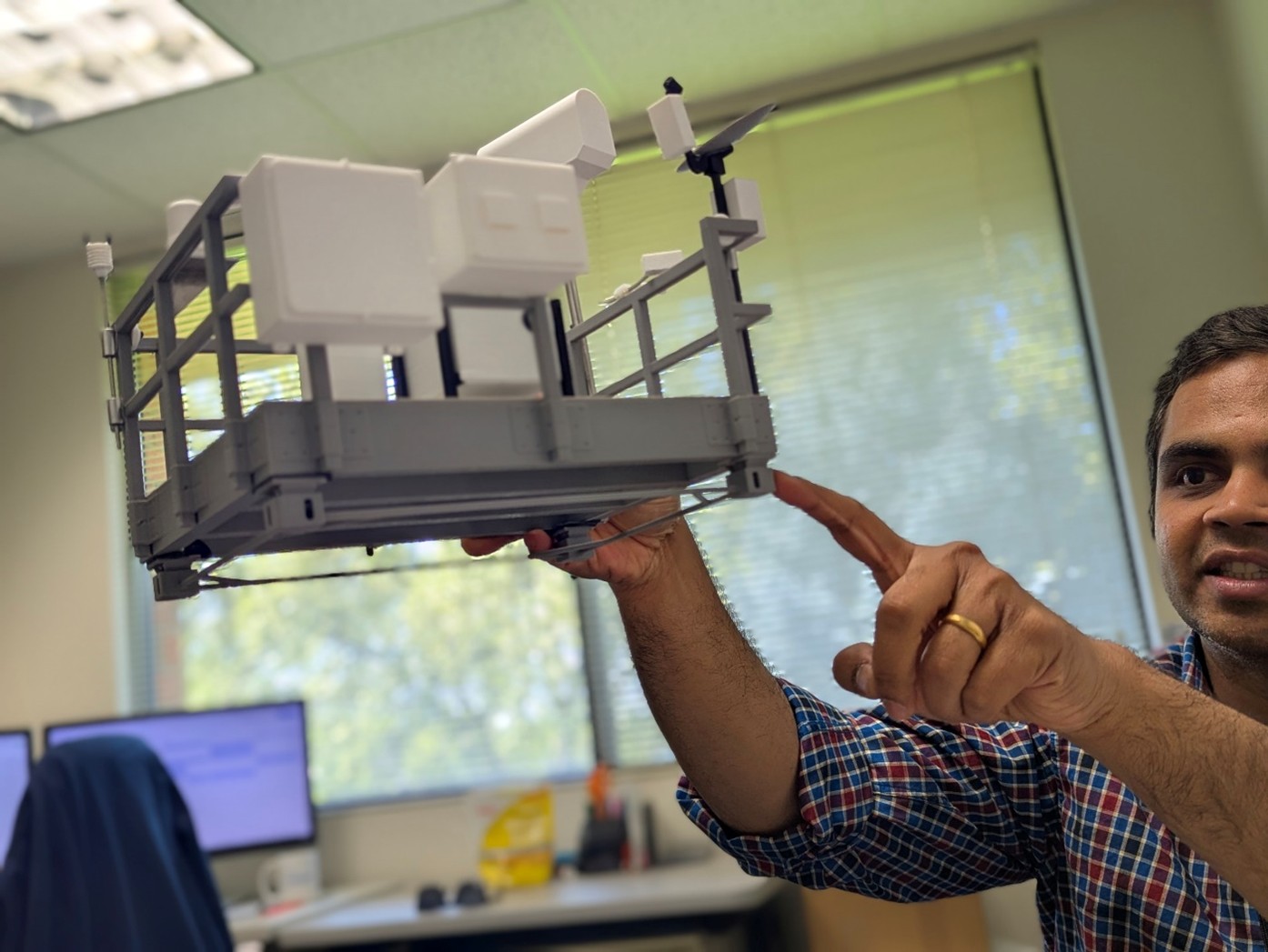Beyond “Science as Usual”
Scientists at PNNL are addressing big challenges using big science

Image by Sara Levine | Pacific Northwest National Laboratory
Scientific innovations are often heralded as the work of great individuals whose independent contributions move their fields forward with prodigious leaps—people love a hero story. Looking closer, we find that many discoveries are nearly simultaneously developed by multiple groups. Newton and Leibniz developed calculus independently, Alfred Russel Wallace is credited for the co-discovery of natural selection with Charles Darwin, and controversy still surrounds the credit for the recent development of CRISPR. In reality, it is the fertile ground of the collective works of many that creates the space for discovery in the first place. Open collaboration across groups is a hallmark of science at Pacific Northwest National Laboratory (PNNL) and a characteristic that may have inspired our own simultaneous discovery story.
Across the Lab, in multiple research groups, the same question has arisen: “How can we go bigger and collect data that transcends our limitations as small, individual teams?” Maybe PNNL’s culture was the inspiration; maybe a national movement toward more collaborative science set the scene. One thing is certain: PNNL scientists in multiple fields decided that if they could start movements to collect and share data across many researchers and geographies, the impact would be worthwhile.
This is where our story about distributed science begins: when conventional and traditional approaches aren’t enough on their own. Over the last decade, scientists at PNNL have been at the forefront of accelerating distributed science programs. Their work is generating foundational knowledge across diverse systems, from the atmosphere and soils to inland watersheds and coastal environments. Distributed science provides important regional context that makes new knowledge transferable, meaning the results and inferences have broad value and relevance across a range of people and places.
The promise and principles of distributed science
Distributed science does not prescribe a one-size-fits-all approach; rather, it encourages researchers to fold in aspects of the framework where and when it’s feasible. In an ideal scenario, a fully realized distributed science effort begins well before data collection, starting with collaborative project design and methods development. It continues through coordinated data generation, and data sharing by researchers across the nation, and worldwide. Everything then culminates in collaborative analysis and manuscript writing that encourages contributions from all participants, regardless of location or institution. By embedding this collaborative spirit throughout the whole research cycle, distributed science greatly increases the potential for outcomes that meet the needs of both the sponsor and the wider community.
This is where distributed science truly shines—when agencies, scientific institutions, and experts across disciplines and locations come together to jointly create new knowledge, data, and models of connected systems to help deploy solutions and actionable insights.
These outcomes can be elevated even further when data are made broadly available and ready for use in emerging AI tools. Ensuring that the data produced by distributed science programs are “AI-ready” also means that the important background information can be easily understood and used for future research.
Distributed science in action: from rivers to coasts
One of the first distributed science projects established at PNNL was the Worldwide Hydrobiogeochemistry Observation Network for Dynamic River Systems (WHONDRS), which is still going strong today. This consortium studies river corridors all over the world, with an emphasis on the continental United States.
Amy Goldman, a co-founder of WHONDRS alongside fellow PNNL scientist James Stegen, explains, “We typically start by identifying a science question in support of our sponsor’s mission and then bring that question to the research community to help refine it to increase impact across a broad range of interested parties.” After that, she and the rest of the team iterate openly to design the study to achieve mutual benefit. They then equip volunteers to start sampling for molecular and biogeochemical characterization. “It is critical in distributed science that the studies are mutually beneficial to both the core research team and to the hundreds of volunteers we engage,” says Goldman. “A one-sided relationship will not succeed.”
WHONDRS also democratizes data collection while fostering a global community committed to shared outcomes. ”It's about understanding Earth system processes at scale and how locally gathered data contribute to a global outlook,” says Kayla Borton, an assistant professor at Colorado State University.
Borton leads a distributed science effort that uses data collected by WHONDRS to understand the microbiomes of rivers across the United States. “This is all still somewhat of a new frontier, but we’re already seeing the transformative impact that a worldwide network of volunteers can make to amass critical information,” she says. Through their efforts, Borton and her team have already had success predicting the structure and function of river microbiomes, key indicators of river health, with the GROWdb project. With this foundation, researchers can now move beyond broad surveys to tackle specific microbiome questions in rivers, including mechanistic studies in under-sampled river types.
Not long after WHONDRS began, PNNL’s Coastal Observations, Mechanisms, and Predictions Across Systems and Scales - Field Measurements and Experiments (COMPASS-FME) project started a distributed science initiative that focuses on ecosystems across the coastal interface of Great Lakes and Mid-Atlantic regions.
Currently co-led by fellow PNNL scientists, Allison Myers-Pigg and Kaizad Patel, the Exploration of Coastal Hydrobiogeochemistry Across a Network of Gradients and Experiments (EXCHANGE) project uses a distributed science approach to study the complex places where land and water meet. A core tenet of the distributed science approach is ongoing co-creation through extensive collaboration with partners throughout the research life cycle.
Integrating sampling across soils, sediments, and surface water, EXCHANGE has generated thousands of data points at partner research sites. For one part of this effort studying material decomposition rates, tea bags are shipped from PNNL to consortium members, who bury them at their research sites for 3 months. Once returned to PNNL, the tea bags are analyzed to determine how the conditions at each site affected the decomposition of the contents. "By conducting standardized experiments across a broad range of sites, we can better inform our Earth system models on how different ecosystem characteristics may drive differences in decomposition rates," says Myers-Pigg. The information from these efforts has led to a deeper understanding of nutrient transformations across the land-to-water transition in the Chesapeake Bay and the Great Lakes.

Expanding distributed science to the open ocean
Distributed science at PNNL isn’t limited to a specific environment or data focus. A new project at the Lab is applying this approach in coastal and open-ocean environments.
The Boundary Layer Exploration of Aerosols and Clouds ON Ships (BEACONS) project is working with the shipping industry to deploy a compact and autonomous array of aerosol and atmospheric sensors that need minimal intervention from the vessel crews. These arrays are designed to take measurements across the open ocean, where there would otherwise be little to no sampling.
Raghavendra Krishnamurthy leads the BEACONS project, which is currently readying its first deployment of equipment on a commercial ship. As Krishnamurthy explains, “We’re helping to fill in missing cloud observations. We can already measure the tops of clouds using satellites, but there’s no reliable way to measure their full depth, which is important for weather forecasting and other meteorological applications.”
By relying on commercial ships equipped with scientific instruments, BEACONS will extend observation capabilities beyond what would traditionally be possible through land-based or satellite means, filling crucial data gaps in meteorology.
Krishnamurthy became involved in the project because of his long-standing expertise with much of the same instrumentation that will now be going on the “vessels of opportunity” involved in the BEACONS project. When asked about what’s been one of the most exciting aspects of this work, aside from the distributed science aspects of it, Krishnamurthy emphasized the unique opportunity he’s been afforded to work with nonscientists on a research project.
“I’ve been thrilled that the ship operators we’ve been working with are excited about BEACONS, and it’s because these data can actually be used to help them in their own work,” he said, adding “improved weather forecasting models, particularly those focusing on fog dynamics, enable the shipping industry to better plan ship routes better, minimize risks and optimizes fuel consumption.” Fog dynamics are a key hypothesis explored under the BEACONS project.

A molecular collective
You can’t understand what you don’t measure, especially when trying to measure what you can’t see with the naked eye.
Another outgrowth from other distributed science projects at PNNL is the Molecular Observation Network (MONet). The project launched in 2023, and it aims to make large, standardized databases of biogeochemical data from soils available for the scientific community.
Led by scientists at the Environmental Molecular Science Laboratory (EMSL) user facility, PNNL, and the Joint Genome Institute, MONet has already amassed a considerable molecular inventory of information related to sample sites across the continental United States.
John Bargar is the lead for MONet, and he explains that distributed science methods have the potential to generate extremely robust datasets. “Ultimately, these data help you see important relationships that are hiding in plain sight, which means they have far more power than we’ll ever know, and it speaks to the importance of building and supporting a distributed community.”
This molecular information is foundational for developing integrated human-Earth system models and predicting mineral and nutrient cycling. As Bargar explains, “It’s through this molecular-level understanding that strides can be made in land use, agriculture, and critical mineral research.”
The future of large-scale, open Earth systems science
The projects highlighted here demonstrate a transformative shift in scientific methodology toward more distributed and accessible data collection and analysis.
Distributed science is transforming the pace, scope, and impact of research. PNNL’s leadership in this approach to scientific inquiry has only continued to expand over the last decade, and these projects show the foundational work built at the Lab.
All the projects highlighted are also strong champions for AI-ready data; when data are “AI-ready,” they can be readily interpreted, require little preparation for use, are accurate, and have comprehensive associated metadata (data about the data). This natural complement to distributed science methodology allows for the more rapid deployment and integration of data into scientific models, addressing various needs more efficiently.
“I didn’t realize I was a data geek until I started working on this project,” Bargar reflects. “I came to understand that driving meaningful change in how we do science has to begin with the data. We need to start there and work backward.”
As Earth and energy system challenges become more complex, embracing distributed science—backed by institutions like PNNL—is more than just an approach. It’s the next step in how we understand, measure, manage, and interpret the Earth systems around us.
Published: November 17, 2025